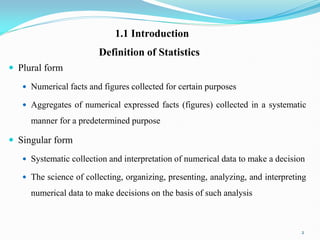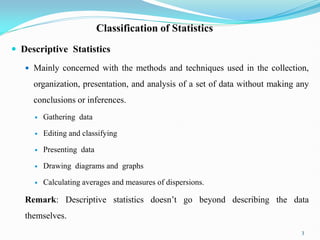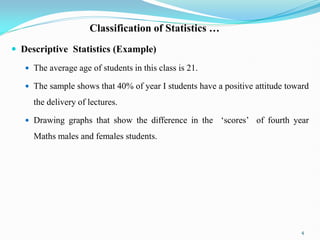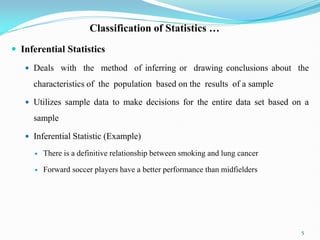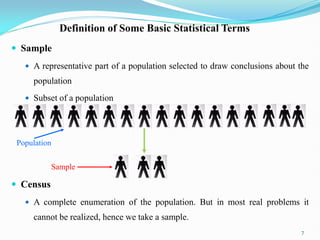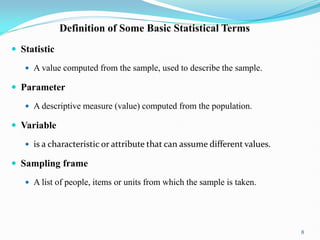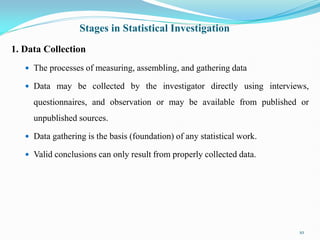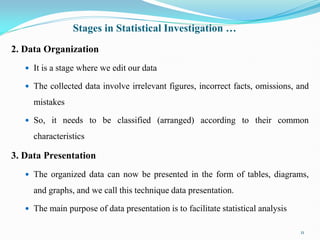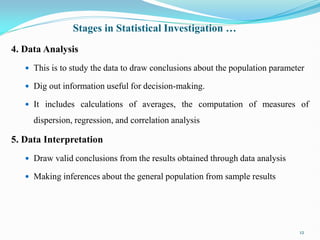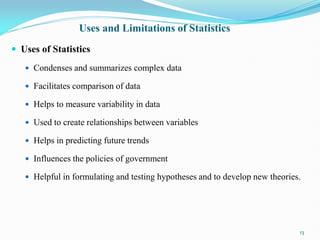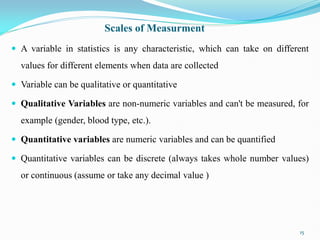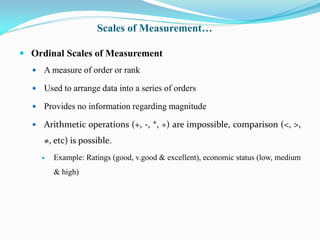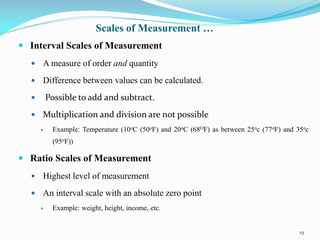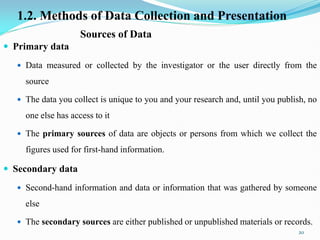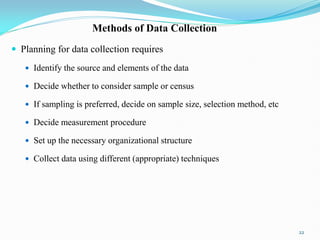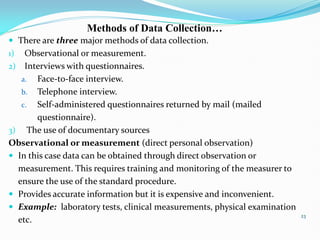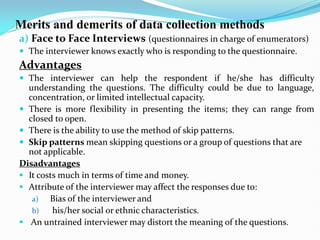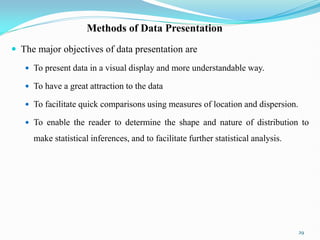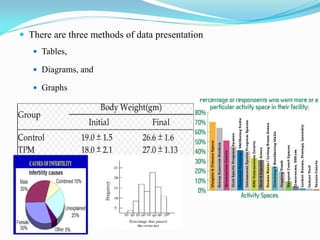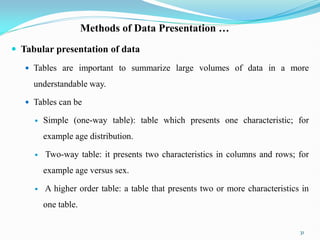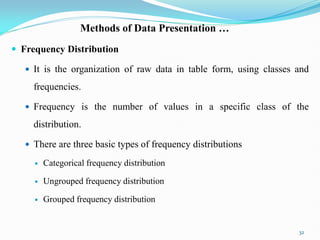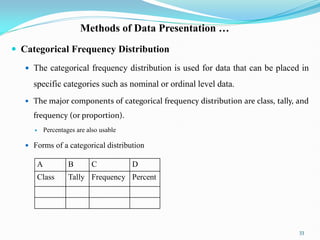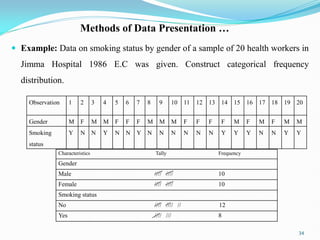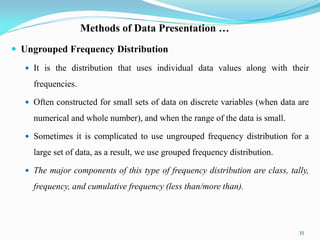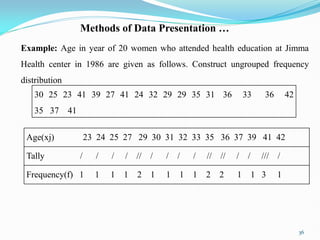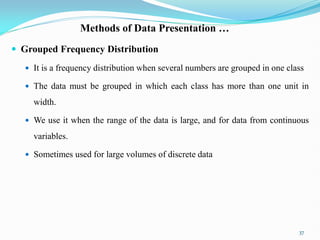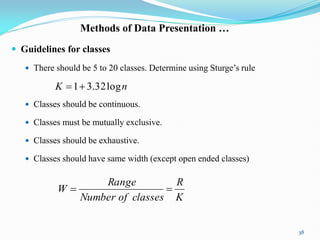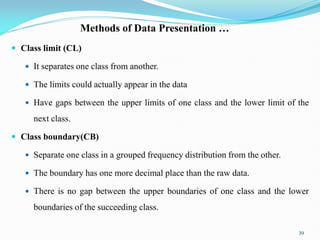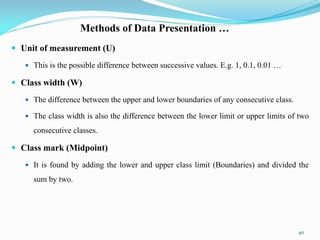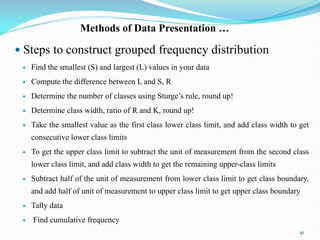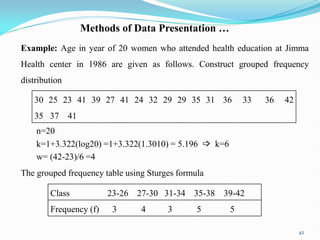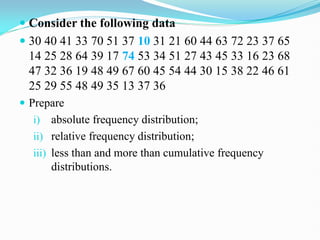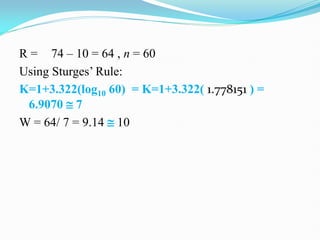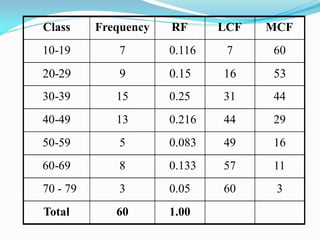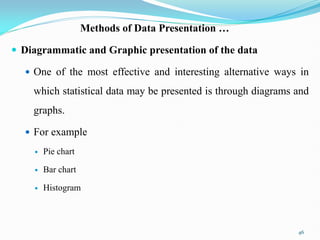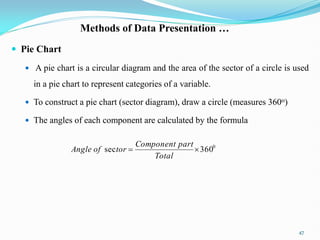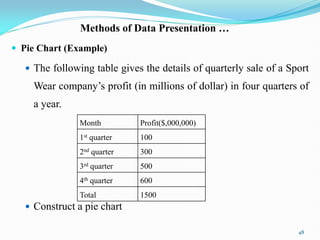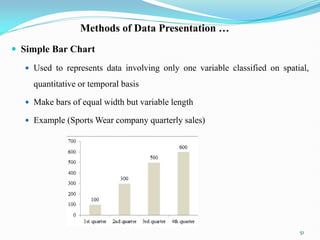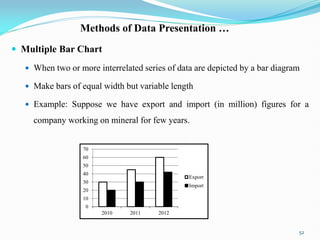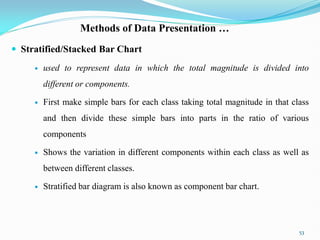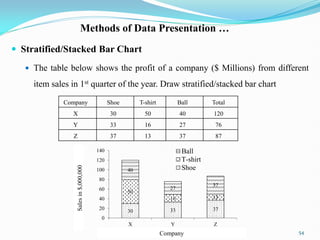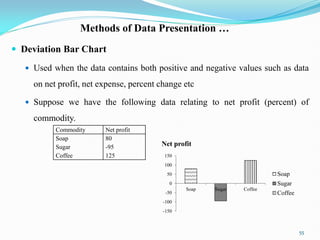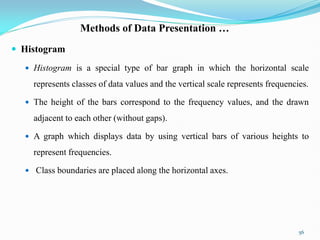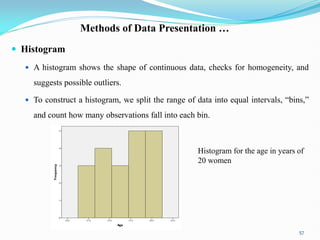CHAPTER 1.pdf Probability and Statistics for Engineers
- 1. Probability and Statistics for Engineers (Stat 2171) Addis Ababa University College of Natural and Computational Sciences Statistics Department
- 2. Definition of Statistics Plural form Numerical facts and figures collected for certain purposes Aggregates of numerical expressed facts (figures) collected in a systematic manner for a predetermined purpose Singular form Systematic collection and interpretation of numerical data to make a decision The science of collecting, organizing, presenting, analyzing, and interpreting numerical data to make decisions on the basis of such analysis 2 1.1 Introduction
- 3. Classification of Statistics Descriptive Statistics Mainly concerned with the methods and techniques used in the collection, organization, presentation, and analysis of a set of data without making any conclusions or inferences. Gathering data Editing and classifying Presenting data Drawing diagrams and graphs Calculating averages and measures of dispersions. Remark: Descriptive statistics doesn‟t go beyond describing the data themselves. 3
- 4. Classification of Statistics … Descriptive Statistics (Example) The average age of students in this class is 21. The sample shows that 40% of year I students have a positive attitude toward the delivery of lectures. Drawing graphs that show the difference in the „scores‟ of fourth year Maths males and females students. 4
- 5. Classification of Statistics … Inferential Statistics Deals with the method of inferring or drawing conclusions about the characteristics of the population based on the results of a sample Utilizes sample data to make decisions for the entire data set based on a sample Inferential Statistic (Example) There is a definitive relationship between smoking and lung cancer Forward soccer players have a better performance than midfielders 5
- 6. Definition of Some Basic Statistical Terms Data A collection of related facts and figures from which conclusions may be drawn A scientific term for facts, figures, information, and measurement Population/target population A totality of things, objects, peoples, etc., about which information is being collected, in which it has common characteristics. Often too large to sample in its entirety Example: population of athletes fed a certain type of diet 6
- 7. Definition of Some Basic Statistical Terms Sample A representative part of a population selected to draw conclusions about the population Subset of a population Census A complete enumeration of the population. But in most real problems it cannot be realized, hence we take a sample. 7 Population Sample
- 8. Definition of Some Basic Statistical Terms Statistic A value computed from the sample, used to describe the sample. Parameter A descriptive measure (value) computed from the population. Variable is a characteristic or attribute that can assume different values. Sampling frame A list of people, items or units from which the sample is taken. 8
- 9. Stages in Statistical Investigation Statistical data must possess the following properties The data must be an aggregate of facts They must be affected to a marked extent by a multiplicity of causes They must be estimated according to reasonable standards of accuracy The data must be collected in a systematic manner for a predefined purpose The data should be placed in relation to each other 9
- 10. Stages in Statistical Investigation 1. Data Collection The processes of measuring, assembling, and gathering data Data may be collected by the investigator directly using interviews, questionnaires, and observation or may be available from published or unpublished sources. Data gathering is the basis (foundation) of any statistical work. Valid conclusions can only result from properly collected data. 10
- 11. Stages in Statistical Investigation … 2. Data Organization It is a stage where we edit our data The collected data involve irrelevant figures, incorrect facts, omissions, and mistakes So, it needs to be classified (arranged) according to their common characteristics 3. Data Presentation The organized data can now be presented in the form of tables, diagrams, and graphs, and we call this technique data presentation. The main purpose of data presentation is to facilitate statistical analysis 11
- 12. Stages in Statistical Investigation … 4. Data Analysis This is to study the data to draw conclusions about the population parameter Dig out information useful for decision-making. It includes calculations of averages, the computation of measures of dispersion, regression, and correlation analysis 5. Data Interpretation Draw valid conclusions from the results obtained through data analysis Making inferences about the general population from sample results 12
- 13. Uses and Limitations of Statistics Uses of Statistics Condenses and summarizes complex data Facilitates comparison of data Helps to measure variability in data Used to create relationships between variables Helps in predicting future trends Influences the policies of government Helpful in formulating and testing hypotheses and to develop new theories. 13
- 14. Uses and Limitations of Statistics … Limitations of Statistics Statistics doesn‟t deal with single (individual) values; rather it deals with aggregate values. Statistics can‟t deal with qualitative characteristics indirectly. Statistical conclusions are not universally true; it depends on the sample that we take. Statistical interpretations require a high degree of skill and understanding of the subject Statistics can be misused by individuals. 14
- 15. Scales of Measurment A variable in statistics is any characteristic, which can take on different values for different elements when data are collected Variable can be qualitative or quantitative Qualitative Variables are non-numeric variables and can't be measured, for example (gender, blood type, etc.). Quantitative variables are numeric variables and can be quantified Quantitative variables can be discrete (always takes whole number values) or continuous (assume or take any decimal value ) 15
- 16. Scales of Measurement Measurement “is assigning numbers to objects, events, or abstract concepts according to a known set of rules” This permits data to be categorized, quantified, and/or analyzed in order that meaningful conclusions can be drawn. There are four scales of measurement that are identified 16 Nominal Scale Ordinal Scale Interval Scale Ratio Scale Highest Level Lowest Level
- 17. Scales of Measurement Nominal Scales of Measurement A measure of identity or category into mutually exclusive classes Useful for quantifying qualitative data Provides no information regarding either order or magnitude Arithmetic operations (+, -, *, ÷) are not applicable, comparison (<, >, ≠, etc) is impossible Example: Blood type (A, B, AB, and O), Name of A student, Identification number 17
- 18. Ordinal Scales of Measurement A measure of order or rank Used to arrange data into a series of orders Provides no information regarding magnitude Arithmetic operations (+, -, *, ÷) are impossible, comparison (<, >, ≠, etc) is possible. Example: Ratings (good, v.good & excellent), economic status (low, medium & high) Scales of Measurement…
- 19. Scales of Measurement … Interval Scales of Measurement A measure of order and quantity Difference between values can be calculated. Possible to add and subtract. Multiplication and division are not possible Example: Temperature (10oC (50oF) and 20oC (68OF) as between 25oc (77oF) and 35oc (95oF)) Ratio Scales of Measurement Highest level of measurement An interval scale with an absolute zero point Example: weight, height, income, etc. 19
- 20. Sources of Data Primary data Data measured or collected by the investigator or the user directly from the source The data you collect is unique to you and your research and, until you publish, no one else has access to it The primary sources of data are objects or persons from which we collect the figures used for first-hand information. Secondary data Second-hand information and data or information that was gathered by someone else The secondary sources are either published or unpublished materials or records. 20 1.2. Methods of Data Collection and Presentation
- 21. Few sources of secondary data are: 21
- 22. Methods of Data Collection Planning for data collection requires Identify the source and elements of the data Decide whether to consider sample or census If sampling is preferred, decide on sample size, selection method, etc Decide measurement procedure Set up the necessary organizational structure Collect data using different (appropriate) techniques 22
- 23. There are three major methods of data collection. 1) Observational or measurement. 2) Interviews with questionnaires. a. Face-to-face interview. b. Telephone interview. c. Self-administered questionnaires returned by mail (mailed questionnaire). 3) The use of documentary sources Observational or measurement (direct personal observation) In this case data can be obtained through direct observation or measurement. This requires training and monitoring of the measurer to ensure the use of the standard procedure. Provides accurate information but it is expensive and inconvenient. Example: laboratory tests, clinical measurements, physical examination etc. 23 Methods of Data Collection…
- 24. Interview with questionnaires: Hear one draft of a detailed questionnaire. These questionnaires can either be mailed to the respondent for filling and returning or can be put in charge of the enumerators who go around and fill them after obtaining the desired information. Questionnaires: These are written documents that instruct the reader or listener to answer the questions written on them. Respondents (Interviewees): are individuals who have answered the questions on the questionnaire. Interviewers: are individuals who are recorded the responses given by the respondents. 24
- 25. Merits and demerits of data collection methods a) Face to Face Interviews (questionnaires in charge of enumerators) The interviewer knows exactly who is responding to the questionnaire. Advantages The interviewer can help the respondent if he/she has difficulty understanding the questions. The difficulty could be due to language, concentration, or limited intellectual capacity. There is more flexibility in presenting the items; they can range from closed to open. There is the ability to use the method of skip patterns. Skip patterns mean skipping questions or a group of questions that are not applicable. Disadvantages It costs much in terms of time and money. Attribute of the interviewer may affect the responses due to: a) Bias of the interviewer and b) his/her social or ethnic characteristics. An untrained interviewer may distort the meaning of the questions.
- 26. b. Telephone Interviews Advantages • It is less expensive in time and money compared with face-to-face interviews. • The interviewer is able to help the respondent if he/she doesn’t understand the question (as seen with a face-to-face interview) • Broad representative samples can be obtained for those who have telephone lines. Disadvantage Under representation of those groups which do not have telephones. Respondent may be substituted by another. Problem with unlisted telephone number in the directory. 26
- 27. 27 c. Self-administered questionnaires returned by mail (mailed questionnaire) Here the questionnaire is mailed to the respondents to be filled. Sometimes it is known as self-enumeration. Advantages These are the cheapest. There is no need for a trained interviewer. There is no interviewer bias. Disadvantage • Low response rate • Uncompleted questionnaires due to omission or invalid responses. • No assurance that the questionnaire was answered by the right person • Needs intense follow-up to get a high response rate.
- 28. 3. The use of documentary sources Extracting information from existing sources (e.g. Hospital records) is much less expensive than the other two methods. It can be an important source of data. Advantages of secondary data Secondary data may help to clarify or redefine the definition of the problem as part of the exploratory research process. Provides a larger database as compared to primary data Time saving Does not involve collection of data Disadvantages of secondary data It is difficult to get the information needed when records are compiled in an unstandardized manner. Lack of availability Lack of relevance Inaccurate data Insufficient data
- 29. Methods of Data Presentation The major objectives of data presentation are To present data in a visual display and more understandable way. To have a great attraction to the data To facilitate quick comparisons using measures of location and dispersion. To enable the reader to determine the shape and nature of distribution to make statistical inferences, and to facilitate further statistical analysis. 29
- 30. There are three methods of data presentation Tables, Diagrams, and Graphs
- 31. Methods of Data Presentation … Tabular presentation of data Tables are important to summarize large volumes of data in a more understandable way. Tables can be Simple (one-way table): table which presents one characteristic; for example age distribution. Two-way table: it presents two characteristics in columns and rows; for example age versus sex. A higher order table: a table that presents two or more characteristics in one table. 31
- 32. Methods of Data Presentation … Frequency Distribution It is the organization of raw data in table form, using classes and frequencies. Frequency is the number of values in a specific class of the distribution. There are three basic types of frequency distributions Categorical frequency distribution Ungrouped frequency distribution Grouped frequency distribution 32
- 33. Methods of Data Presentation … Categorical Frequency Distribution The categorical frequency distribution is used for data that can be placed in specific categories such as nominal or ordinal level data. The major components of categorical frequency distribution are class, tally, and frequency (or proportion). Percentages are also usable Forms of a categorical distribution 33 A B C D Class Tally Frequency Percent
- 34. Methods of Data Presentation … Example: Data on smoking status by gender of a sample of 20 health workers in Jimma Hospital 1986 E.C was given. Construct categorical frequency distribution. 34 Observation 1 2 3 4 5 6 7 8 9 10 11 12 13 14 15 16 17 18 19 20 Gender M F M M F F F M M M F F F F M F M F M M Smoking status Y N N Y N N Y N N N N N N Y Y Y N N Y Y Characteristics Tally Frequency Gender Male //// //// 10 Female //// //// 10 Smoking status No //// //// // 12 Yes //// /// 8
- 35. Methods of Data Presentation … Ungrouped Frequency Distribution It is the distribution that uses individual data values along with their frequencies. Often constructed for small sets of data on discrete variables (when data are numerical and whole number), and when the range of the data is small. Sometimes it is complicated to use ungrouped frequency distribution for a large set of data, as a result, we use grouped frequency distribution. The major components of this type of frequency distribution are class, tally, frequency, and cumulative frequency (less than/more than). 35
- 36. Methods of Data Presentation … Example: Age in year of 20 women who attended health education at Jimma Health center in 1986 are given as follows. Construct ungrouped frequency distribution 36 30 25 23 41 39 27 41 24 32 29 29 35 31 36 33 36 42 35 37 41 Age(xj) 23 24 25 27 29 30 31 32 33 35 36 37 39 41 42 Tally / / / / // / / / / // // / / /// / Frequency(f) 1 1 1 1 2 1 1 1 1 2 2 1 1 3 1
- 37. Methods of Data Presentation … Grouped Frequency Distribution It is a frequency distribution when several numbers are grouped in one class The data must be grouped in which each class has more than one unit in width. We use it when the range of the data is large, and for data from continuous variables. Sometimes used for large volumes of discrete data 37
- 38. Methods of Data Presentation … Guidelines for classes There should be 5 to 20 classes. Determine using Sturge‟s rule Classes should be continuous. Classes must be mutually exclusive. Classes should be exhaustive. Classes should have same width (except open ended classes) 38 n K log 32 . 3 1 K R classes of Number Range W
- 39. Methods of Data Presentation … Class limit (CL) It separates one class from another. The limits could actually appear in the data Have gaps between the upper limits of one class and the lower limit of the next class. Class boundary(CB) Separate one class in a grouped frequency distribution from the other. The boundary has one more decimal place than the raw data. There is no gap between the upper boundaries of one class and the lower boundaries of the succeeding class. 39
- 40. Methods of Data Presentation … Unit of measurement (U) This is the possible difference between successive values. E.g. 1, 0.1, 0.01 … Class width (W) The difference between the upper and lower boundaries of any consecutive class. The class width is also the difference between the lower limit or upper limits of two consecutive classes. Class mark (Midpoint) It is found by adding the lower and upper class limit (Boundaries) and divided the sum by two. 40
- 41. Methods of Data Presentation … Steps to construct grouped frequency distribution Find the smallest (S) and largest (L) values in your data Compute the difference between L and S, R Determine the number of classes using Sturge‟s rule, round up! Determine class width, ratio of R and K, round up! Take the smallest value as the first class lower class limit, and add class width to get consecutive lower class limits To get the upper class limit to subtract the unit of measurement from the second class lower class limit, and add class width to get the remaining upper-class limits Subtract half of the unit of measurement from lower class limit to get class boundary, and add half of unit of measurement to upper class limit to get upper class boundary Tally data Find cumulative frequency 41
- 42. Methods of Data Presentation … Example: Age in year of 20 women who attended health education at Jimma Health center in 1986 are given as follows. Construct grouped frequency distribution n=20 k=1+3.322(log20) =1+3.322(1.3010) = 5.196 k=6 w= (42-23)/6 =4 The grouped frequency table using Sturges formula 42 30 25 23 41 39 27 41 24 32 29 29 35 31 36 33 36 42 35 37 41 Class 23-26 27-30 31-34 35-38 39-42 Frequency (f) 3 4 3 5 5
- 43. Consider the following data 30 40 41 33 70 51 37 10 31 21 60 44 63 72 23 37 65 14 25 28 64 39 17 74 53 34 51 27 43 45 33 16 23 68 47 32 36 19 48 49 67 60 45 54 44 30 15 38 22 46 61 25 29 55 48 49 35 13 37 36 Prepare i) absolute frequency distribution; ii) relative frequency distribution; iii) less than and more than cumulative frequency distributions.
- 44. R = 74 – 10 = 64 , n = 60 Using Sturges‟ Rule: K=1+3.322(log10 60) = K=1+3.322( 1.778151 ) = 6.9070 7 W = 64/ 7 = 9.14 10
- 45. Class Frequency RF LCF MCF 10-19 7 0.116 7 60 20-29 9 0.15 16 53 30-39 15 0.25 31 44 40-49 13 0.216 44 29 50-59 5 0.083 49 16 60-69 8 0.133 57 11 70 - 79 3 0.05 60 3 Total 60 1.00
- 46. Methods of Data Presentation … Diagrammatic and Graphic presentation of the data One of the most effective and interesting alternative ways in which statistical data may be presented is through diagrams and graphs. For example Pie chart Bar chart Histogram 46
- 47. Methods of Data Presentation … Pie Chart A pie chart is a circular diagram and the area of the sector of a circle is used in a pie chart to represent categories of a variable. To construct a pie chart (sector diagram), draw a circle (measures 3600) The angles of each component are calculated by the formula 47 0 360 sec Total part Component tor of Angle
- 48. Methods of Data Presentation … Pie Chart (Example) The following table gives the details of quarterly sale of a Sport Wear company‟s profit (in millions of dollar) in four quarters of a year. Construct a pie chart 48 Month Profit($,000,000) 1st quarter 100 2nd quarter 300 3rd quarter 500 4th quarter 600 Total 1500
- 49. Methods of Data Presentation … Pie Chart (Example) 49 Quarter Profit($,000,000) Angle of sector (in degrees) Percent (%) 1st quarter 100 24 7 2nd quarter 300 72 20 3rd quarter 500 120 33 4th quarter 600 144 40 Total 1500 360 100 7% 20% 33% 40% 1st quarter 2nd quarter 3rd quarter 4th quarter
- 50. Methods of Data Presentation … Bar Chart It Uses vertical or horizontal bins to represent the frequencies of a distribution. While we draw a bar chart, we have to consider the following two points. Make the bars the same width as possible Make the units on the axis that are used for the frequency equal in size Bar charts can be Simple bar chart, Multiple bar charts, Stratified or stacked bar chart Deviation bar chart 50
- 51. Methods of Data Presentation … Simple Bar Chart Used to represents data involving only one variable classified on spatial, quantitative or temporal basis Make bars of equal width but variable length Example (Sports Wear company quarterly sales) 51
- 52. Methods of Data Presentation … Multiple Bar Chart When two or more interrelated series of data are depicted by a bar diagram Make bars of equal width but variable length Example: Suppose we have export and import (in million) figures for a company working on mineral for few years. 52 0 10 20 30 40 50 60 70 2010 2011 2012 Export Import
- 53. Methods of Data Presentation … Stratified/Stacked Bar Chart used to represent data in which the total magnitude is divided into different or components. First make simple bars for each class taking total magnitude in that class and then divide these simple bars into parts in the ratio of various components Shows the variation in different components within each class as well as between different classes. Stratified bar diagram is also known as component bar chart. 53
- 54. Methods of Data Presentation … Stratified/Stacked Bar Chart The table below shows the profit of a company ($ Millions) from different item sales in 1st quarter of the year. Draw stratified/stacked bar chart 54 Company Shoe T-shirt Ball Total X 30 50 40 120 Y 33 16 27 76 Z 37 13 37 87 30 33 37 50 16 13 40 27 37 0 20 40 60 80 100 120 140 X Y Z Ball T-shirt Shoe Company Sales in $,000,000
- 55. Methods of Data Presentation … Deviation Bar Chart Used when the data contains both positive and negative values such as data on net profit, net expense, percent change etc Suppose we have the following data relating to net profit (percent) of commodity. 55 Commodity Net profit Soap Sugar Coffee 80 -95 125 -150 -100 -50 0 50 100 150 Soap Sugar Coffee Net profit Soap Sugar Coffee
- 56. Methods of Data Presentation … Histogram Histogram is a special type of bar graph in which the horizontal scale represents classes of data values and the vertical scale represents frequencies. The height of the bars correspond to the frequency values, and the drawn adjacent to each other (without gaps). A graph which displays data by using vertical bars of various heights to represent frequencies. Class boundaries are placed along the horizontal axes. 56
- 57. Methods of Data Presentation … Histogram A histogram shows the shape of continuous data, checks for homogeneity, and suggests possible outliers. To construct a histogram, we split the range of data into equal intervals, “bins,” and count how many observations fall into each bin. 57 Histogram for the age in years of 20 women

